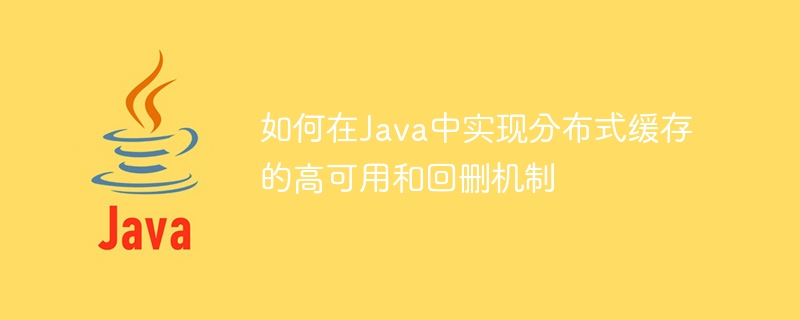

How to implement high availability and deletion mechanism of distributed cache in Java
Introduction:
With the advent of the big data era, distributed cache as A high-performance, high-availability solution that is widely used in various Internet applications. In order to ensure the high availability of the distributed cache and the consistency of the data, we need to implement a high availability mechanism and a deletion mechanism based on it. This article will introduce how to implement high availability and deletion mechanism of distributed cache in Java, and provide specific code examples.
1. High availability mechanism
In order to ensure the high availability of distributed cache, we can achieve it through master-slave replication and sharding mechanisms. Master-slave replication can copy data to multiple nodes to implement backup functions. When the master node goes down, you can select a slave node as the new master node to ensure the normal operation of the system. The sharding mechanism can divide data into multiple fragments and store them on different nodes. When a node goes down, it will only affect the data on that node, while the data on other nodes can still be accessed normally.
Specific implementation:
JedisPoolConfig config = new JedisPoolConfig(); // 创建连接池配置对象
JedisPool pool = new JedisPool(config, "masterIP", 6379); // 创建主节点连接池
// 指定从节点的IP和端口
List<JedisShardInfo> shards = Arrays.asList(
new JedisShardInfo("slave1IP", 6379),
new JedisShardInfo("slave2IP", 6379)
);
JedisSentinelPool sentinelPool = new JedisSentinelPool("mymaster", shards, pool); // 创建哨兵连接池
Jedis jedis = sentinelPool.getResource(); // 获取连接对象
jedis.set("key", "value"); // 设置缓存
String value = jedis.get("key"); // 获取缓存ConsistentHash<CacheNode> consistentHash = new ConsistentHash<>(new HashFunction(), 100, nodeList); // 创建一致性哈希对象 CacheNode node = consistentHash.get(cacheKey); // 根据缓存键获取对应的节点 node.put(cacheKey, cacheValue); // 将缓存数据存储在对应的节点上 String value = node.get(cacheKey); // 从对应的节点获取缓存数据
2. Delete back mechanism
In order to ensure the consistency of cached data, we need to implement a delete back mechanism in the application. The deletion mechanism can update or delete the corresponding data in the cache at the same time when the data is updated or deleted.
Specific implementation:
void updateData(String key, Object newValue) {
// 更新数据库中的数据
updateDatabase(key, newValue);
// 更新缓存中的数据
updateCache(key, newValue);
}
void updateCache(String key, Object newValue) {
Cache cache = getCache(); // 获取缓存对象
cache.put(key, newValue); // 更新缓存数据
}void deleteData(String key) {
// 删除数据库中的数据
deleteDatabase(key);
// 删除缓存中的数据
deleteCache(key);
}
void deleteCache(String key) {
Cache cache = getCache(); // 获取缓存对象
cache.remove(key); // 删除缓存数据
}Conclusion:
This article introduces how to implement the high availability and deletion mechanism of distributed cache in Java, and provides specific code examples. The mechanism to achieve high availability and the deletion mechanism can effectively ensure the stability of distributed cache and data consistency, and improve the performance and reliability of the system. I hope this article will be helpful to readers in the design and development of distributed caches in practical applications.
The above is the detailed content of How to implement high availability and deletion mechanism of distributed cache in Java. For more information, please follow other related articles on the PHP Chinese website!
 what is mysql index
what is mysql index
 What is highlighting in jquery
What is highlighting in jquery
 Ethereum browser blockchain query
Ethereum browser blockchain query
 How to retrieve Douyin flames after they are gone?
How to retrieve Douyin flames after they are gone?
 How to solve the problem of 400 bad request when the web page displays
How to solve the problem of 400 bad request when the web page displays
 Commonly used search tools
Commonly used search tools
 Free software for building websites
Free software for building websites
 What is the basic concept of artificial intelligence
What is the basic concept of artificial intelligence




